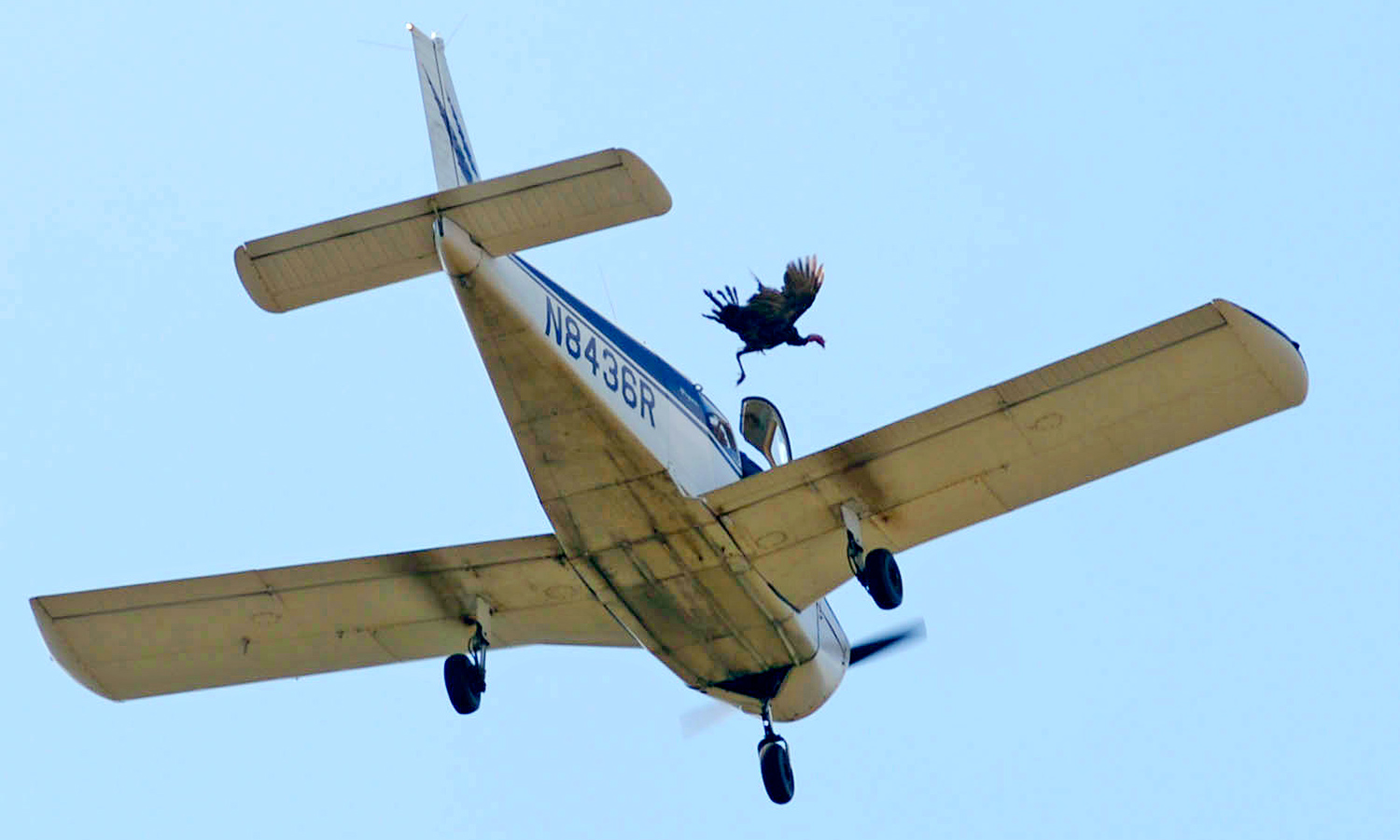What Happens When You Drop a Turkey from a Plane?

Domestic turkeys can't fly — but that hasn't stopped people in a small town in Arkansas from dropping the birds from small planes at an annual festival event that has drawn opposition from animal-rights activists.
While turkeys can't flap their wings and soar as many other birds can, they can slow their falls somewhat, Michael Habib, a professor of anatomy at the University of Southern California, told Live Science. "A lot of flightless birds have wings that can produce lift; it's just not enough to fly," said Habib, who studies the evolution of flight in birds.
The festival is the annual Turkey Trot in Yellville. For the past 50 years during the festival, a local pilot has flown a plane and dropped domestic turkeys from a height of about 500 feet (150 meters) over local fields, according to the Huffington Post. [10 Weird Facts About Turkeys]
The problem for the domestic turkeys is that, while they can slow a fall, they can't do it forever — it depends on how long they can keep flapping their wings. Habib noted that turkeys are very powerful for short periods, just like human sprinters. However, they can't keep up that activity for long. So, during the first part of the descent at least, the turkeys likely flap their wings wildly, and they "fly" similarly to their wild cousins.
According to the "Ask the Van" site at the University of Illinois physics department, when birds fly, their wings push air down and generate thrust, pushing the bird up. And as the wings come up, they bend and push less air because they aren't spread out anymore. That's what allows the average flying bird to keep itself up and, just as importantly, generate some forward motion. The forward motion creates lift, because as air flows over the bird, the layer of air above it is less dense than that below, and the bird rides on the more-dense layer. This is also why some bird species can soar, like eagles and vultures. Given enough forward thrust, a bird can glide and "coast" along, because the shape of the wing creates an airflow that is less dense on top of it, just like an airplane's wing. The birds that do this really well like albatrosses have long wingspans and small bodies.
But domestic turkeys are so heavy relative to their wing area that they can't really do either powered flight or gliding well, Habib said. The combined upward thrust and lift simply isn't enough to overcome the bird's weight. [Amazing Physics: How 245 People Jumped Off a Bridge at Once — and Survived]
This is why, as reported by Arkansas Online, out of a dozen turkeys dropped at the 2016 event, two died on impact. The turkeys can't really glide well, given their shape and weight, Habib said. Even though turkey wings can create a little bit of lift, they don't have the optimal shape to do so, and their bodies are too heavy for it to work, according to Habib.
Get the world’s most fascinating discoveries delivered straight to your inbox.
Other birds have even less ability to slow falls in this way. "Ostriches wouldn't have any more success than you or I would," he said. That's because their wings are simply too small relative to their body size to generate any significant lift at all, he said.
Domestic turkeys can't fly, but wild turkeys can, Habib said. Like other birds in their order, called Galliformes, wild turkeys just can't fly for long — just long enough to get up into a tree or out of danger.
Some young birds in this order — which includes chickens, geese and peacocks — sometimes use their wings to help them climb up trees or inclines. When they need to get down, they use their wings to break their fall. This happens a lot with a bird called the chukar, which is native to Eurasia. The altitude they can reach — limited by trees and small cliffs — is nowhere near the altitude the turkeys are dropped from at the Turkey Trot.
This flight ability (or inability) can be seen in the "color" of the birds' meat. Habib noted that the metabolism of the muscles in their legs and wings are one of the reasons the meat is light or dark. Dark meat — in the legs, for example — has muscle that contains myoglobin, an oxygen-carrying molecule that allows them to work efficiently for longer periods. When it cooks, it becomes darker.
White meat is "fast-twitch" muscle that doesn't use as much oxygen because it isn't designed to work for long, but it's powerful. The breast (which powers the wings) is fast-twitch muscle, and it's why the breast meat is lighter in color. Myoglobin is why long-distance flyers, like ducks, have dark meat in the breast that looks more like steak. That powerful, fast-twitch muscle explains why a relatively heavy bird — the wild turkey — can fly but tires quickly, Habib said.
Flightlessness can be bred in birds; that's what happened with domestic turkeys and chickens. But it can also appear in birds that live without any pressure from predators because there's no reason to have escapist skills. The kakapo (in the parrot family) and the dodo, which was related to pigeons, became flightless in that way. Habib noted that, in both cases, there were few ground-level predators on these animals' island habitats. Kakapos are native to New Zealand and were driven to near extinction when humans introduced rats and cats to the area. Dodos, which lived on Mauritius, are thought to have been killed by humans for food, but they also became victims of the rats that humans introduced. The last dodos died in the 17th century.
But regardless of turkeys' abilities, it's not good for them to be dropped. "It's really unethical," Habib said.
Originally published on Live Science.



